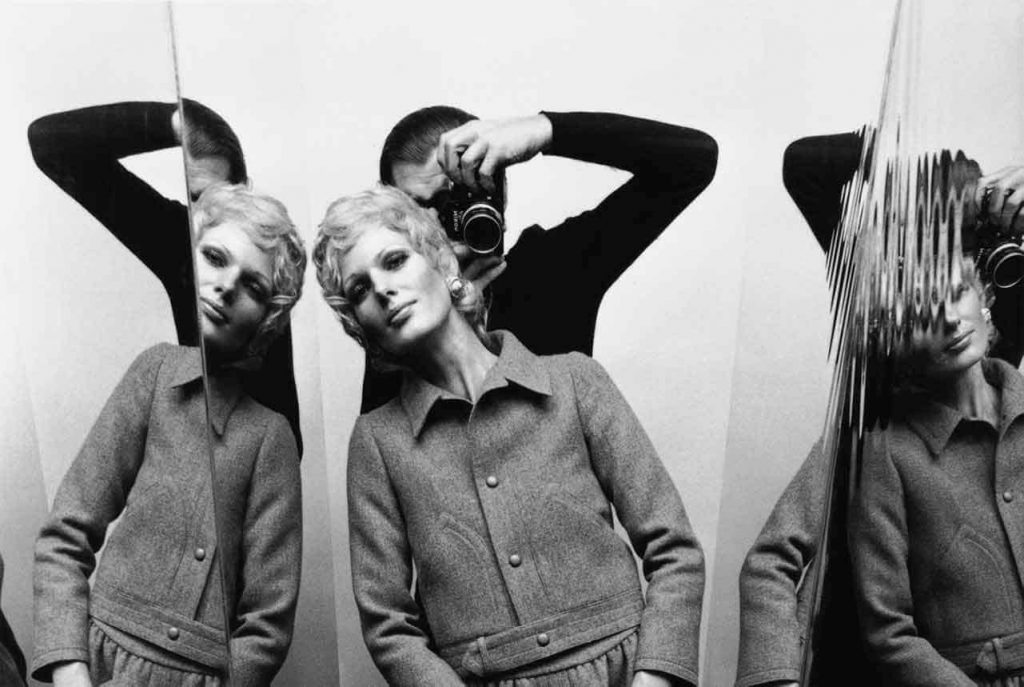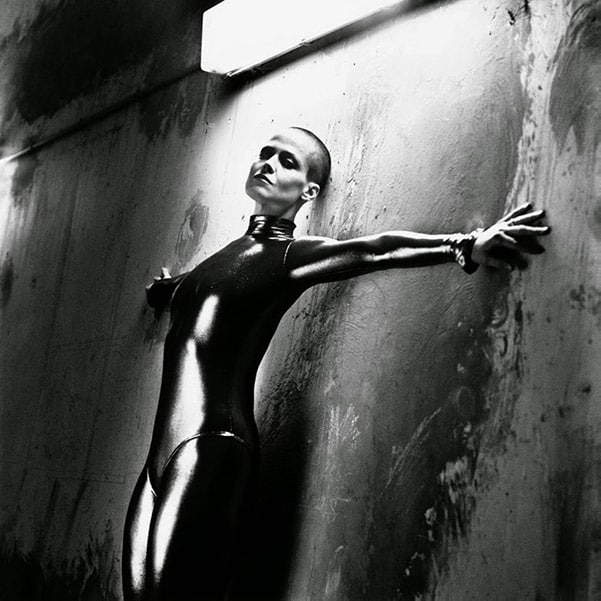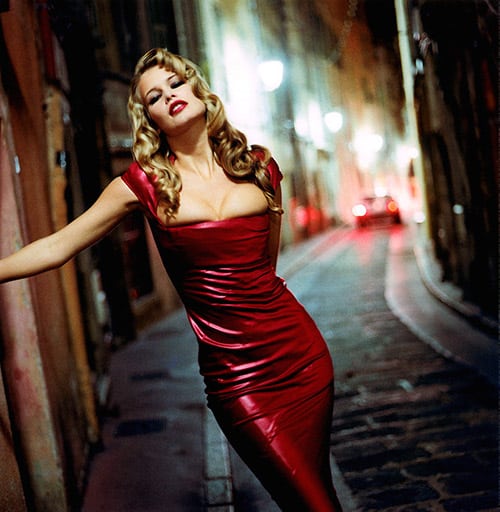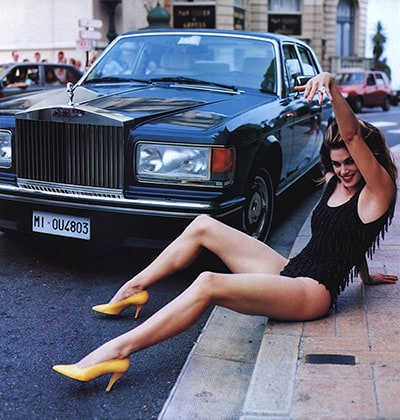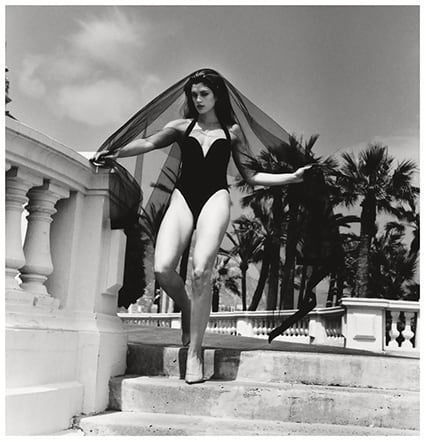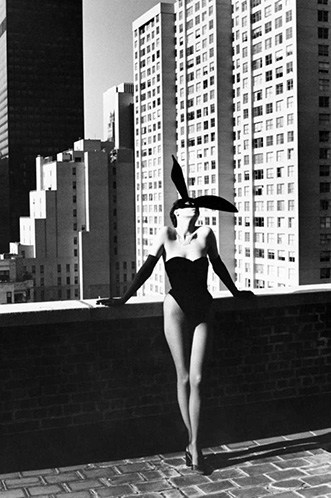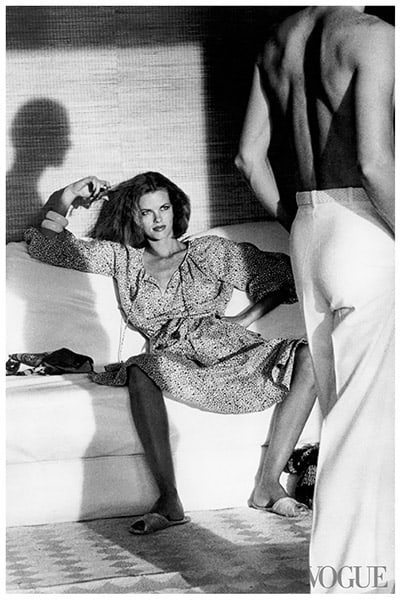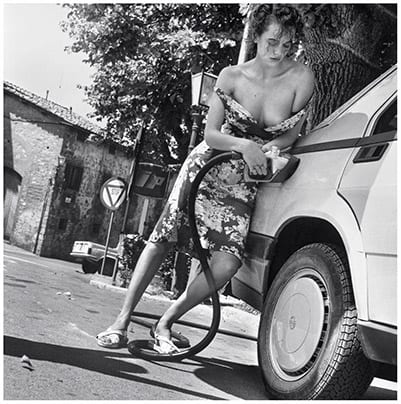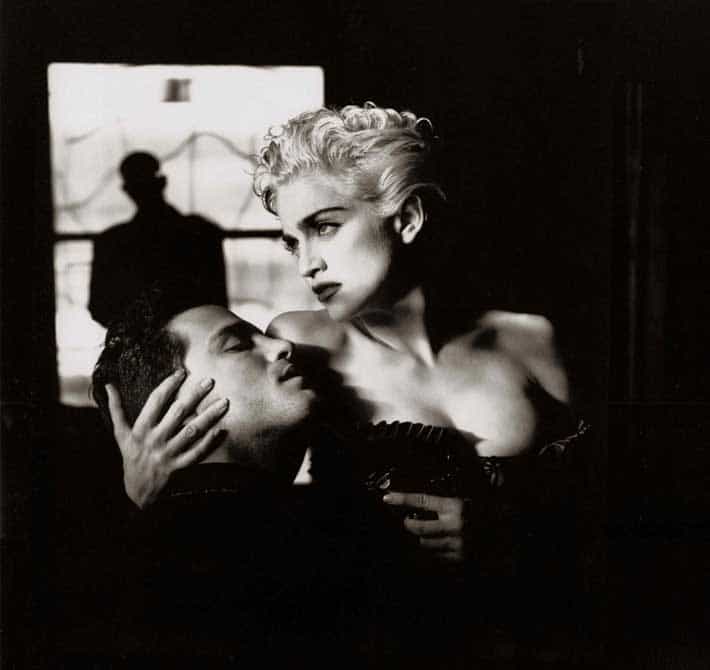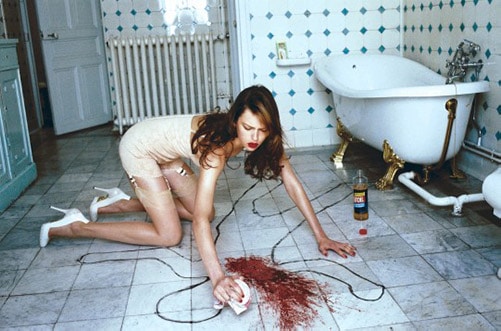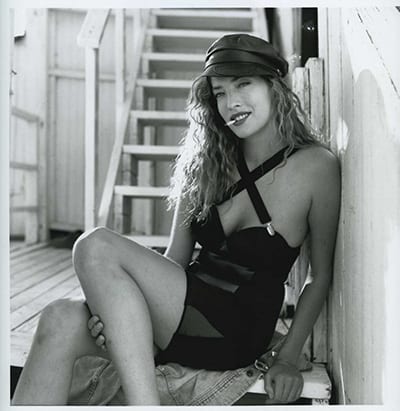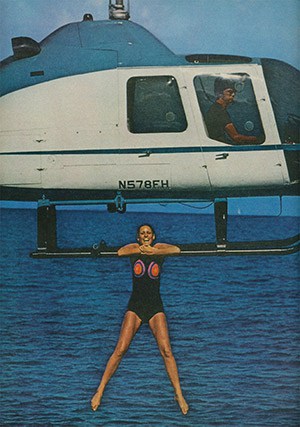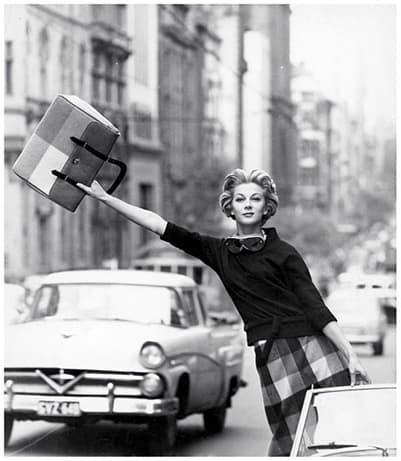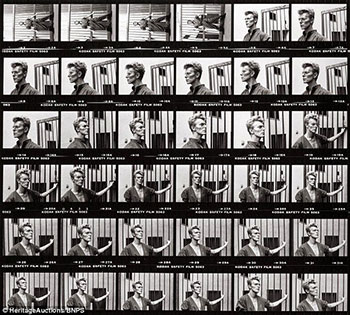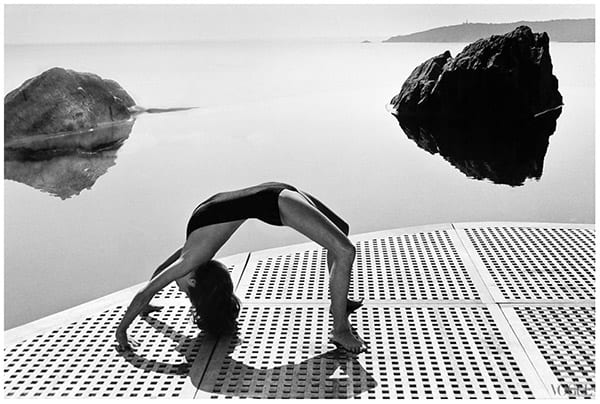With an illustrious career spanning five decades, Helmut Newton is widely recognized as one of the greatest photographers of the 20th century.
This Complete Guide to Helmut Newton is the ultimate resource for anyone looking for information about the legendary photographer and his work.
There have been thousands of websites that have written about Newton, but to find truly great content takes a lot of searching and many wasted hours (even wasted days).
After extensive research, I’ve compiled everything I could find out about Newton and his career into one easy to read post.
If there’s anything you want to know about Helmut Newton, you’re guaranteed to find it in the article below.
This is the most comprehensive and definitive guide on Helmut Newton that you’ll ever read on the internet. Period.
If you enjoy reading it, then I would be grateful if you could share it, so other photographers like you can also enjoy the article.
This will be quite long, so make yourself a drink or grab a beer and sit back and enjoy the read.
If you don’t have time to read the full article now (around 25 minutes), then bookmark the page and read it a section at a time.
Alternatively, feel free to use the table of contents below, to skip ahead to whatever section interests you.
Related: The Best 101 Helmut Newton Quotes
Editor Note: This article took 14 days to research and write. Sharing the website or linking back to us takes less than a minute and costs you absolutely nothing. To show your appreciation, I would be extremely grateful if you could share the website through social media or photography forums, or even link back to Photogpedia on your own blog or portfolio website (every link counts). Thank you for your support.
Table of Contents
Biography
Name: Helmut Newton (Neustädter)
Nationality: German/Australian Photographer
Genre: Fashion, Commercial, Nude, Eroticism
Born: October 31, 1920 – Berlin, Germany
Died: January 23, 2004 – Los Angeles, United States
Introduction
Dubbed the ‘King of Kink’ by Time Magazine in 1976, Newton was a prolific photographer and pioneer, whose daring work bought him both fame and notoriety.
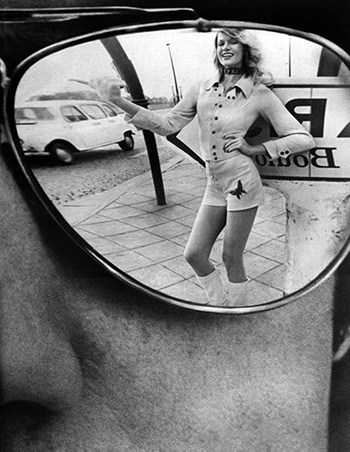
In the 1970s, his work for Vogue, Vanity Fair and Elle revolutionized fashion photography and paved the way for contemporary photography to become more creative and risky.
Incorporating complex themes of sexuality in his work and shooting on location, he showed that fashion photography didn’t have to be safe and confined to the studio.
His bold, seductive and controversial style continues to influence many brands, photographers and advertisers today.
Sixteen years after his death, he remains a major influence on photography and the visual art world.
Who Is Helmut Newton?
Where to begin…
A master of the craft and genuine visionary, Newton was one of a few photographers who transformed fashion photography and advertising into what can be considered an art form.
Building on major avant-garde art movements of the 20th century, he blended themes of voyeurism and glamour to create a style that has since become an everyday part of the fashion landscape.
Pushing the Envelope
He began as a fashion photographer who pushed the boundaries of what was deemed acceptable at the time for editors, then pushed them even further in his personal work.
He challenged taboos and preferred his models tall and posed with precision and attitude, playing the part of out-of-reach goddesses.
He photographed some of the most beautiful women in the world in poses that emphasized their sexuality, often with an accompanying sense of danger and violence.
His dreamlike and erotic photos were like peeping through a keyhole, spied moments of heightened reality.
Watch this behind the scenes video from Helmut by June to see for yourself.
Visual Storyteller
When you look at a Newton photograph, it’s like seeing a frame from the middle of a movie and wondering what will happen next.
As Wallis Annenberg put it:
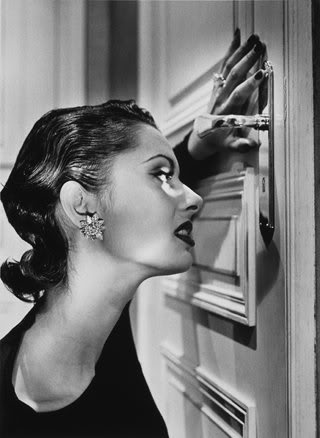
If Newton’s work was controversial, I believe it’s because he expressed the contradictions within all of us, and particularly within the women he photographed so beautifully: empowerment mixed with vulnerability, sensuality tempered by depravity. Newton deepened our understanding of changing gender roles, of the ways in which beauty creates its own kind of power and corruption. On top of that, his compositions were brilliantly precise, cinematic in their scope and in their storytelling.
In his career, Newton worked with Vogue, Vanity Fair, Elle, Nova and Playboy, shooting over 60 covers for Vogue Paris alone.
His provocative, erotically charged photos were a mainstay of Vogue and other publications during the sexual revolution of the 1960s and ‘70s.
During this 20-year period, his work reached millions of readers.
Gun for Hire
He also worked in advertising, shooting various campaigns for the likes of Yves Saint Laurent, Chanel and Versace as well as non-fashion brands such as BMW and Absolute Vodka.
As his career developed and his reputation grew, he began taking portraits of celebrities for magazines and has photographed everyone from David Lynch and Madonna to Margaret Thatcher and Leonardo DiCaprio.
Today, his photographs are some of the most valuable around (his famous, Sie Kommen sold for $670,000 in 2016 at Sotheby’s New York) and a rare version of his book Sumo is one of the most expensive photography books to go under the hammer, selling for $430,000.
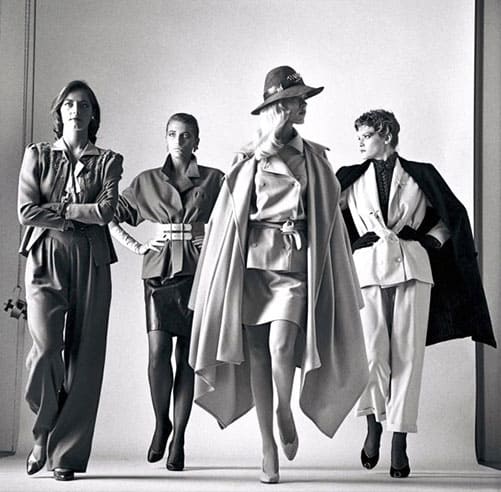
Early Life
Helmut Neustädter (he later changed his name to Newton) was born on the 31st of October 1920 into a prosperous Jewish family in Weimar, Berlin. His mother Klara was a widow with a son, Hans when she married Helmut’s father, Max.
Max was a soldier from Silesia before marrying Klara. He later went on to take over the running of the button factory left behind by Klara’s late husband.
Although Jewish by descent, they celebrated Christmas rather than Hanukkah and neither Helmut nor his half-brother Hans had a Bar Mitzvah.
Newton’s liking for the unusual, particularly in sexual contexts, is attributed to his early years.
At 8 years old, his older brother showed him the ‘gutter of Berlin’, which was inhabited by prostitutes like ‘Red Erma’, who wore thigh-high boots and carried a whip. Helmut recalls, “my eyes were poppin’ out of my head.”
This early exposure would later lead him to create photographic studies that altered the course of fashion photography.
Enter Photography
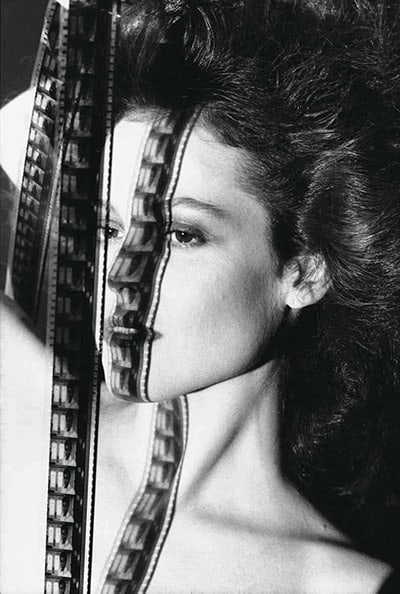
From the age of 12, when he saved up enough money to buy a Box Brownie, he wanted to be a photographer. The first roll of film he ever shot was at an underground subway. The whole roll came back black except for the one image he shot above ground.
He attended the Heinrich von Treitschke Real Gymnasium and later the American School in Berlin, where he was often truant, already more interested in photography than his academic studies.
In love with Marlene Dietrich, so he said, from the time he attended the American School, he met her many years later when they were both in New York and he was to take her portrait.
The meeting was not a success – she took offense to a light-hearted comment by Newton – and the portrait was never taken.
The Young Rebel
A rebel at the age of fourteen, encouraged by the confidence of family wealth and the decadence of Berlin society of the 1930s, Helmut Newton dangerously flaunted the Nuremberg racial laws of 1934 and fell in love with an Aryan girl.
Newton later said, “I was pretty much awake to it but didn’t give a shit one way or the other.”
At fourteen I took pictures of my childhood girlfriends in the streets, dressed in my mother’s dresses and hats. It was then that I swore to myself that I would later become a fashion photographer at Vogue.
Helmut Newton – 1976 April/May issue of Penthouse Photo World
On his own account, Helmut excelled at only three subjects during his teenage years: swimming, photography and sex.
My grades, in school, were deplorable, I was a dunce. Since my classes ended at 1 PM when I was fourteen years old, I got a job as an assistant to a photographer without telling my parents. This lasted for six months. My school grades became worse and worse; So finally, my father confiscated all my cameras and confined me to the house. By the time I was sixteen, my parents no longer had any hope.
Helmut Newton – 1976 April/May issue of Penthouse Photo World
Helmut the Apprentice
In 1936, at the age of 16, he managed to persuade his father to allow him to pursue a career in photography. “You’ll end up in the gutter,” his father warned. “I’m still not far from the gutter, I’m glad to say,” Newton reflected towards the end of his life. “I like it down there.”
He secured an apprenticeship with the popular portrait and theatrical photographer, Else Ernestine Neuländer-Simon, known professionally as Yva.
German-Jewish Yva had a reputation for innovation and was a regular exhibitor at international photography exhibitions, including, daringly for a woman at the time, the International Salon of nude photography in Paris.
She experimented with a multiple exposure technique, creating surreal, dream-like effects current with the German avant-garde, and paving the way for the emergence of a new vision of femininity.
An important influence during his formative years as a photographer, he remained with her for two years.
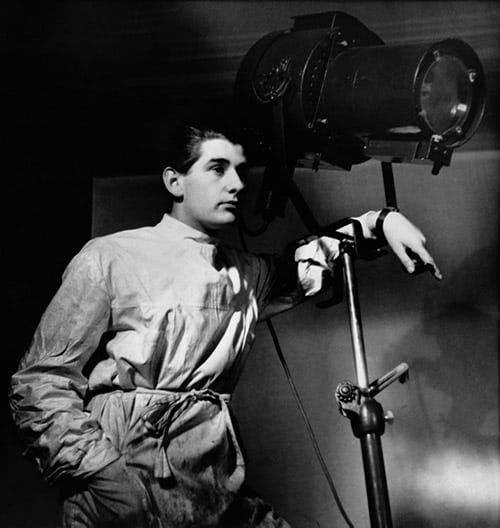
World War II
Unfortunately, hoping things would change in Germany, she decided against leaving as the Nazi’s took power. She ended up being deprived of her studio and was killed in the Majdanek concentration camp in December 1944.
The situation in Berlin became increasingly more dangerous for Jews, and in 1938, following Kristallnacht, Newton’s father was briefly imprisoned in a concentration camp.
No longer able to ignore the change of political climate in Germany, Helmut’s father was forced to abandon the factory and the family emigrated to South America.
Helmut, who at the time was 18, could not get a visa and was sent instead to China.
At Trieste, he boarded the ‘Conte Rosso’ (along with about 200 others escaping the Nazis) intending to journey to China. Taking with him a small bag of belongings and two still cameras, he instead got off in Singapore.
Going It Alone
In Singapore, he worked as a photographer for the Strait Times (lasting only two weeks) and then as a portrait photographer.
When I was 18, I was in Singapore and flat broke. The Singapore Straight Times offered me a job as a reporter. I had a beat-up Rolleiflex, but every time there was something to take a photo about, I got there too late. After two weeks they fired me, and for a long time I didn’t have any money.
From Helmut Newton by Helmut Newton
According to his autobiography, he worked also as a gigolo, or, at least the kept plaything for a much-older rich French divorcée.
During this time, Helmut photographed society parties in the British colony of Singapore. As he still had a German passport, he was interned by the British in 1940 as a ‘friendly enemy alien’ and sent to Australia on board the Queen Mary.
Down Under
Arriving in Sydney in September 1940 he was taken to an internment camp in Tatura, Victoria, where he remained until 1942.
After his release, following a few weeks of casual work as a fruit picker, he enlisted as a truck driver in the Australian army during World War II.
After the end of the war, he became an Australian citizen and changed his name to Newton. He then decided to follow his dream, opening his first photography studio in 1946 determined to make a living as a photographer.
In 1946, Newton set up shop in fashionable Flinders Lane in Melbourne and worked in fashion and theatre photography in the affluent post-war years.
June
During this time, he met an actress June F Browne, who performed under the stage name June Brunell. Two years later Browne and Newton married. This partnership that would last a lifetime.
When he proposed to June, he told her, “We would never be rich, we’d always be poor and that photography would always be my first love, and you would be my second.”
Her influence seems to have been considerable: the notion of an actress as a model is hardly a new one, but Browne’s collaboration with Newton, on both sides of the camera, was substantial and she became his trusted editor and inspiration for the rest of their life together.
Browne later became a successful photographer under the pseudonym Alice Springs (after Alice Springs, the Australian town.)
Eighteen years after fleeing Germany, at the age of 36, he landed his first commission with Vogue, leading him to the path that would see him become one of the fashion photography industry’s finest artists.
Photography Career
Early Period
Newton’s early photography work was standard for the time. Like most photographers starting out, he would take any job that he could get including weddings, catalog assignments and even baby books.
For several years, Newton worked tirelessly and over time his reputation eventually grew.
In the mid-50s his hard work paid off when he secured himself a commission at Australian Vogue magazine.
In 1956, Newton partnered with fellow German refugee, Henry Talbot, and changed his studio name to Helmut Newton and Henry Talbot. The pair specialized in fashion and advertising photography. They continued their partnership even after Newton left for Europe.
London Calling
After living in Australia for fifteen years, he was yearning to return to Europe and explore opportunities abroad. His work at Australian Vogue won him a 12-month contract with British Vogue and in February 1957, Helmut and June moved to London.
My years in Australia were wonderful. I met June, we married, but photographically, as much as I loved this country and its people, it did not form me as a photographer nor did my work there amount to anything.
His time with British Vogue was in his own words “boring.” Newton thought he took the worst pictures of his life, owing largely to the British conservative views and lack of talent for sex. He left for Paris before his contract was up.
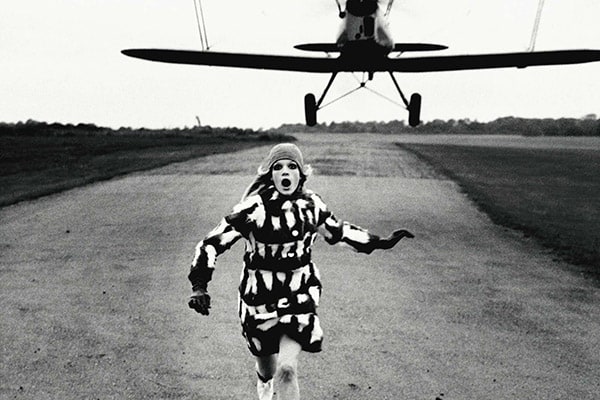
Bonjour Paris
The day I arrived in Paris, it was love at first sight. I knew that I would live in this city. In a week, I could get around Paris with my eyes covered. But by the end of a year, I had no more money. I was hardly working. The editorial pages of fashion magazines paid badly and my photographs were not good.
After short spells working for French and German fashion magazines, and a return to Australian Vogue in 1959 for two years, Helmut again returned to Paris in 1961, taking up residence in the fashionable district of La Marais.
The moment I hit Paris I knew this was it for living and taking photographs. The life was in the streets, in cafes, restaurants. Beautiful women seemed to be everywhere.
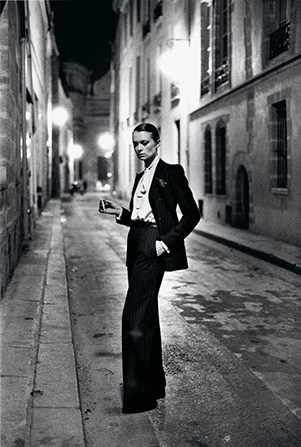
Rue Aubriot, Paris, 1975 © Helmut Newton Estate
It is there that he made the iconic portrait of a woman wearing a Yves Saint Laurent tuxedo, nicknamed Le Smoking.
Going International
From this new locale, his work appeared internationally in magazines such as Elle, French Vogue, Jardin des Modes, Harper’s Bazaar, Nova and Playboy.
His full-time contract with French Vogue, together with commissions from other magazines such as British Vogue and Queen, gave Helmut the financial freedom to explore his own vision for fashion photography.
It was his body of work during this period which established his reputation as a world-renowned fashion photographer.
Under the Influence
Yet no matter where he was shooting, Newton always brought a 1920s Berlin sensibility to his photography, where smoky nostalgia and decadence were seen in every film, cabaret or song of the day.
He was also inspired by the work of Brassaï and his innovative street photography, and portraits of the rich and famous.
Newton replaced the reserved and objectified images of models with women who exuded confidence and sexuality and weren’t afraid to use it as a means of dominance in a man’s world.
His photos were gritty, in your face and a complete contrast to fashion photos of the past.
This departure proved successful, attracting assignments from elite fashion magazines of the day.
The editor-in-chief of French Vogue, Francine Crescent, was a champion of his new vision following her appointment in 1968.
Combining the glamour and decadence of high fashion, along with erotically charged voyeurism against a cinematic backdrop, made the clothes seem unattainably desirable and emphasized the equally unattainable femininity of the models.
American Vogue
Although Newton worked on several assignments for American Vogue, his style of photography failed to impress Diana Vreeland, the then editor of American Vogue, who preferred a glamorized and glossy look, and he decided to call it quits and return to Paris.
Mrs. Vreeland’s vision was one of fantasia, Moroccan extravaganzas, rouged heels – yes! – and dreams of exotica. Mine was a highly sexual woman, in all respects Western, whose native habitat was Paris, Milan, and maybe New York.
He finally made his return to its pages in 1971, shortly after Ms. Vreeland was fired.
The world of fashion photography was changing, and Helmut Newton would lead the change for the next two decades.
Mature Period
In 1971 while working on a Vogue assignment in New York, Helmut suffered a major heart attack that would change his life. This near-death experience made him reassess his photography and his work took on a whole new direction.
With encouragement from June, Helmut began concentrating on his nudes and portraits.
He pursued sexual themes, taking pictures “from inside himself” based on memories of his youth in Berlin, introducing a menacing edge to his work.
This change brought him to the forefront of fashion photography and made him one of the most influential figures in his field during the 1970s.
Related Article: 101 Helmut Newton Quotes
The Look
Women were pictured bolder, more confident and more aggressive; usually in disturbing situations, photographed in a gritty, realistic reportage style.
Models were often depicted as members of the social elite, ‘caught’ in seedy environments exploring kinky fantasies.
Some of Newton’s most iconic photo stories were done with Vogue fashion director Polly Mellen. For the December 74 issue, Newton and Mellen went to the island of Maui to shoot the story Hawaii – Adventures in Sundressing.
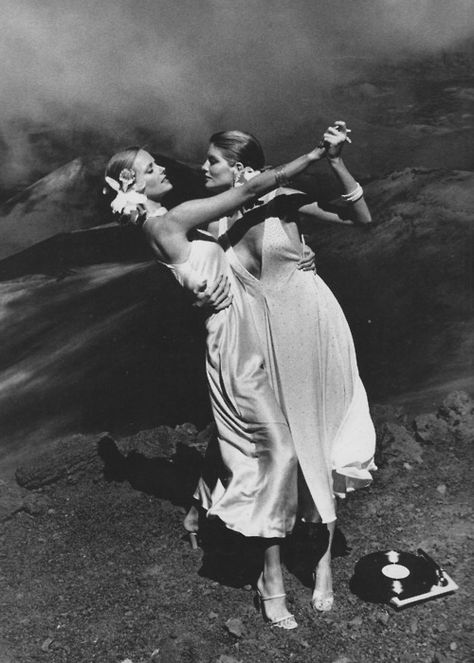
Newton posed future supermodel Cheryl Tiegs with a then-unknown actress Rene Russo. The pair danced to the sound of a phonograph on the edge of the Haleakala crater.
Storm of Controversy
For the time, the lesbian overtones in the picture were scandalous, and readers reactions were divided. The photo story received praise from some readers, while others canceled their subscriptions.
One thing can be said for Helmut, was that he enjoyed a succés de scandale, whether photographing a German model as a Russian spy by the Berlin War, or fashion models posed wearing a saddle or representing women as men.
The term ‘political correctness’ has always appalled me, reminding me of Orwell’s ‘thought police’ and fascist regimes.
Newton on censorship in America
During the 70s actress, Charlotte Rampling famously posed naked for him in a portrait for Playboy. He continued his association with Playboy magazine for a 30-year period.
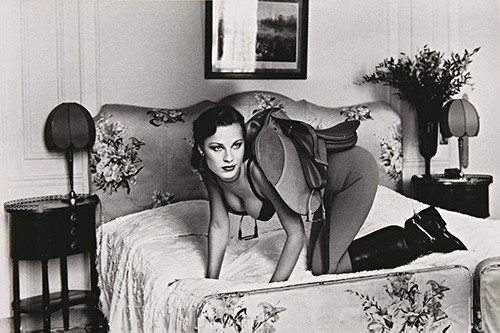
Portraits
Also, that decade, he photographed a number of controversial political figures, including French politician Jean-Marie Le Pen, and British Prime Minister Margaret Thatcher, of whom he said, “As she became more successful and more powerful, she seemed to me to become even sexy.”
With his portrait work, Helmut had the ability to convey the true character of the sitter through a single frame. His portraits were powerful, yet full of contradictions that bring us closer to these seemingly untouchable people.
As Helmut put it: “My job is to seduce, amuse and entertain,” a philosophy which is evident in much of his portrait work.
Portraiture commissions, many of which were published in Vanity Fair, continued throughout the 1980s.
Helmut published his first book ‘White Women’ in 1976, which featured the most radical selections from this period. Despite negative reviews in the US it still managed to sell 1500 copies in the first week there.
Hollywood Years
The Hollywood film The Eyes of Laura Mars starring Faye Dunaway was inspired by Helmut’s photos. Ironically, the photos he contributed to the film were rejected as the director of the film wanted more blood and corpses, which were of no interest to Helmut.
In 1981, Helmut and June left Paris for warmer climates of Monte Carlo in the South of France where they would spend their summer months, returning to Los Angeles in winter.
Towards the latter part of his life, Newton continued to work for advertising clients and publications, including Vanity Fair and Vogue.
Commissions were never in short supply for Helmut, yet despite the busy work schedule, he always found time to take the photographs he wanted to and complete various personal projects.
Check out this behind the scenes video of Helmut on a photoshoot for Vogue in 1991.
Photographic Style
Helmut Newton was a visionary photography who popularised edgy, often racy fashion photos that were inspired by film noir and surrealism.
His photographs were stylized essays in erotica and fantasy. They were dangerous, voyeuristic and provocative but always elegant.
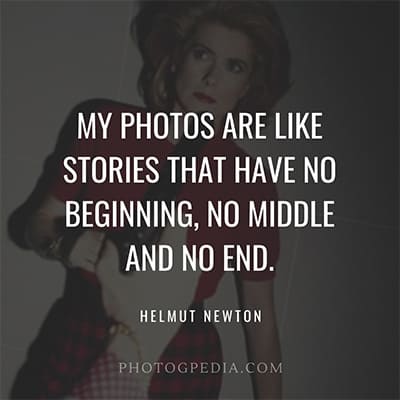
To Newton, fashion meant more than the clothes and models. He focussed on the concept, the story, as well as making the viewer feel an emotional connection to the image.
I still believe that the perfect fashion photograph is a photograph that does not look like a fashion photograph. It’s a photograph that looks like something out of a movie, like a portrait, maybe a souvenir shot, maybe a paparazzi shot, anything but a fashion photograph.
His lighting was contrasty and bold, making use of practical’s and simple lighting techniques such as one flash or a torch (or even car headlights).
As a result, his photographs look more realistic and his compositions arresting.
Influences
He has often borrowed from cinema, journalism, erotica and art.
Newton’s appreciation for the cinema, particularly Film Noir (Dark Film), is evident in his use of low-key lighting, seductive women, black and white film and mysterious narrative elements.
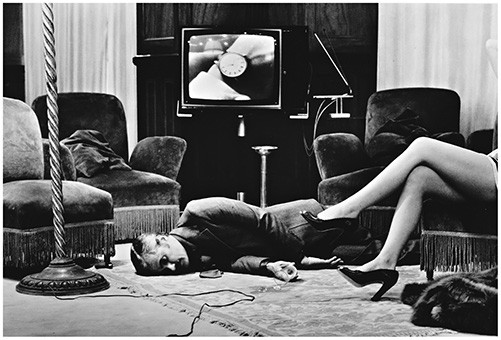
“A woman does not live in front of a white paper” he said, in reference to the studio, “she lives on the street, in a motor car, in a hotel room.” By bringing a journalistic element into his photography, he infused his photographs with human interest.
His work was influenced by his early years in the 1930s, wandering the streets of Berlin with a camera in hand.
He has cited that street photographer Brassai, the German photographer Dr. Erich Salomon (who was one of the first paparazzo) and film director Erich von Stroheim as influences on his work and photographic style.
Brassai inspired me with his pictures of Paris by night. I thought those pictures were incredibly beautiful. I started doing a lot of fashion pictures at night in Paris, and since I’ve been in Monte Carlo I’ve been doing the same here. Night gives a very mysterious quality to a woman in the street. I love that.
Other Photographers Work He Liked
Irving Penn, Richard Avedon, Baron de Meyer, Edward Steichen, William Klein, Weegee, August Sander, George Hurrell and Jacques Henri Lartigue.
Working with Models
Whilst other photographers, such as Irving Penn and Richard Avedon moved fashion photography to a more glamorous, artful presentation often working with celebrities.
Newton instead preferred tall and powerful lesser-known models that could form to the image he had in his head.
Central to his work were women and underlying themes such as power, eroticism and desire. His models projected a mixture of distance and availability.
Helmut was very clear that he liked a big girl and blond girl, in an impeccable suit and high heels. He would take that girl and put her in some wicked or naughty situation, kissing another woman or in handcuffs.
Anna Wintour, editor-in-chief of Vogue
Portrait Work
Of course, Newton didn’t just shoot fashion and beautiful women, he was also acclaimed for his portrait work, photographing celebrities from film, politics, music and popular culture.
Having once remarked that “portraits are an extraordinary seduction.”
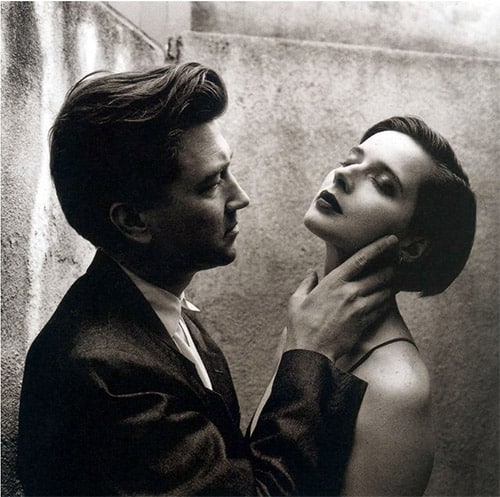
Newton photographed everyone from Leonardo DiCaprio to Angelina Jolie to Margaret Thatcher and Sophia Loren.
For Time magazine, Salvador Dalí, requested that Helmut took his photograph prior to his death.
The King of Kink
Following the release of his erotic book, White Women in 1976, Time magazine gave Newton the nickname, ‘The King of Kink’.
If a photographer says he is not a voyeur, he is an idiot.
Helmut Newton
His photographs of women, while often erotically charged, are never demeaning, and are often almost worshipful of their power and sexuality. His work in various fashion magazines was the first to show nude women as empowered and triumphant.
Newton’s work was not without controversy, but one thing is for sure, he remained uncompromising in his vision until the day he died.
Legacy
Helmut Newton’s photography took eroticism off the top shelf and into the mainstream, changing the look of fashion photography forever.
When Newton began his career in the late 1940s, fashion photography was safe and conventional.
It would have been easy for Helmut to follow the pack and do the same unoriginal work of others, instead he followed his instincts and went in a new direction. Similar to what Picasso did with art.
The result was a body of work that redefined fashion photography and inspired future generations of photographers.
In today’s #metoo environment, Newton’s photos could be considered exploitive and objectifying. The reality is, his photos are evocative, empowering, mysterious, timeless and most of all, beautiful.
He left an indelible mark on the world of photography and helped turn photography into an art form.
His legacy will live on, and the name Helmut Newton will forever be stamped in the history books as one of the greatest photographers of all time.
How did Helmut Newton Die?
Helmut Newton died at the age of 83, as a result of an automobile accident.
Like a narrative from one of his photographs, even his death was remarkable, going out in 2004 in the style of a James Dean.
After suffering a heart attack at the wheel, Helmut lost control of his Cadillac Escalade SUV, and crashed into a wall on Sunset Boulevard, next to the Chateau Marmont Hotel, where he lived in California.
Although June survived the crash, the accident proved to be fatal for Helmut and he passed away on the 23rd of January 2004.
His ashes are buried in his home city of Berlin.
Recognition and Awards
With his reputation firmly established as one of the greatest photographers of the twentieth century, Newton received countless awards in recognition of his contribution to the world of fashion, as well as art and photography.
Here’s a few of them:
- Kodak Award for Photographic Books
- Best Photography Award from the ‘Art Director’s Club’ in Tokyo (1976)
- American Institute of Graphic Arts Award (1977)
- Life Legend Award for Lifetime Achievement in Magazine Photography (1999)
In 2003, Newton donated a large collection of photos to the Prussian Cultural Heritage Foundation in Berlin, the land of his birth. The collection remains there today.
Also, in 2003, a few months before his death, Newton along with his wife June established the Helmut Newton Foundation in Berlin.
The museum is dedicated to preservation and promotion of his own work, along with June’s and is without a doubt worth the visit if you’re ever in Germany.
Sumo
In 1999, Taschen publishing produced a limited-edition book showcasing Newton’s work in fashion and celebrity photography.

Titled Sumo, the 480-page book weighed in at 30kg (66-pounds) and measured 50cm by 70cm (20 in × 28 in).
The book which was signed and numbered by Helmut was initially priced at $1,500, with only 10,000 copies available.
Due to the size and weight of the book, a bespoke stand was designed by French designer and architect Phillipe Starck to support it.
The first copy of Sumo was signed by 80 of the celebrities featured in it including David Lynch, Cindy Crawford and Sigourney Weaver.
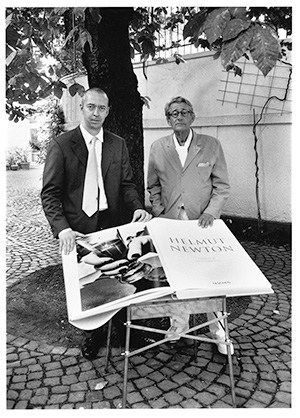
This book was sold at auction in Berlin in August 2000 for a whopping $430,000, making it the most expensive book of the 20th century.
A revised edition, edited by June was released in 2009. Although still a huge book, it was much smaller than the original.
The revised version of Sumo can still be purchased on Amazon.
A preview of the book is available on the Taschen Website.
Newton Facts
- Newton’s work inspired the term ‘Porno Chic’.
- Helmut Newton was color blind and couldn’t differentiate between green and blue.
- Whilst developing the script for the film, Eyes Wide Shut, Stanley Kubrick handed a copy of Newton’s book to the scriptwriter, intended as inspiration.
- The Newton Bar in Berlin was named after Helmut. You can sip a cocktail or enjoy a beer set against the dramatic backdrop of his celebrated ‘Big Nudes’ covering the wall.
- Helmut visited the set of the Francis Ford Coppola film, Dracula for a day and took some publicity stills.
- Actor Brad Pitt owns several copies of Newton’s book, Sumo.
What Camera Did Helmut Newton Use?
With a career spanning over fifty years, Newton experimented with many cameras. After days of research, here are my findings.
The first camera he owned at the age of 12 was a Box Brownie made by Eastman Kodak.
Early in his career, during his Australian days, he used a 10×8 camera with glass plates.
Newton recalls, “The shutter was like a blind that you opened by pulling on a string. Because of retouching, you could only use the large format. Even the 120 of the Rollei was considered too small.”
Since then Newton settled on a Rolleiflex 2.8 for the majority of his work, although he has used just about whatever camera was handed to him, trying to keep his setup as simple as possible.
He owned a Hasselblad 500 but didn’t like to use it as he found it too heavy and too noisy, opting to only use it for studio and commissioned shoots.
Other cameras Newton used over five decades include: 4×5 Graflex Super D, Plaubel Makina 67, Instamatic, Fuji 645, Olympus OM1, Olympus OM2, Nikon FM2, Konica, Pentax-ME, Polaroid, Canon EOS 5, Canon EOS 100 (in his autofocus days) and Olympus Stylus Epic ‘MJU II’ (for casual snapshots.)
Keeping it Simple
What’s noticeable about Newton’s practice is his minimalist approach to the medium. Since starting off as a professional, his camera gear has got smaller and smaller.
I think things are complicated enough without making them more so, I think this is why my technical equipment is very simple, very basic because it gives me more time to work with the girl which is the most important thing.
He once revealed that his equipment composed of just ‘four bodies, five lenses, a strobe light, and a Polaroid, all of which could fit into one bag that weighed less than 40 pounds’. This, he said, allowed him to take pictures anywhere.
What About Focal Length?
Newton has said that he considers 40mm the “perfect focal length,” although a lot of his work is shot using the Rollei and Hasselblad and standard 80mm prime lenses (the equivalent of 50mm in 35mm photography.)
From some of the photos I’ve studied, the notes state that he used his Nikon FM2 with a 50mm F1.4 AI-S.
Although in other interviews, he has said that he likes to use the longest lens possible, but one that allows him to maintain contact with his subject.
Film and Development Process
Newton worked primarily with black and white film, mainly shooting Kodak Tri-X, TMax 100 and TMax 400. For color, he used whatever was available including cheap film from the drugstore, as well as Kodachrome II and Ektachrome X under special conditions.
Typically, he would shoot film at box speed but occasionally when using something like Tri-X he would rate the film at 200 and process as normal.
He wasn’t fond of printing and would rather have his films processed by the lab, so he could spend more time on photoshoots and coming up with ideas.
Marc Picot (Newton’s printer) used HC110, but it might also be that Newton preferred D-76 or even Rodinal. He disliked underexposed and underdevelopment film (thin negatives) and preferred his film to be developed a little longer than recommended, which increased the contrast of the images.
How Do You Get the Helmut Newton Look?
Be born Helmut Newton.
In all honesty, story and composition are more important than any technical aspect of the photograph or what camera he used.
Picking up a film camera, loaded with Kodak Tri-X and developing it in Kodak HC110 will give you a good start. After that, it’s up to you to learn to light and come up with an interesting concept involving an Amazonian blonde in a great location (easier said than done).
Newton would often say that it was only at 50, “he got good” [at photography].
The Process
Here are Helmut’s own words when asked, how do you come up with an idea and plan for a shoot:
It’s a long process. Something no one knows about is that I do all of my work in writing first. I always carry around a little notebook in which I can jot down the minutest details concerning photos that I’ll take some other time. I can’t draw. So, I make notes on props, lighting, the compositional parts of my picture. Perspiration under the arms, puffed-up lips, a kiss, a man’s shoulder, a woman’s hand, the inside of the elbow, the interplay of muscles, of vowels and consonants, a man and woman naked to the waist, a man.
Helmut by Helmut Newton (1987)
In a schoolboy’s notebook in which I write everything that interests me. It is divided into three headings: ideas, girls, places. If I don’t write it down, I forget it. All these notes slumber, evolve, take form. This summer, on a beach at Saint-Tropez, I saw two boys and a girl who lived together happily. The perfect ménage à trois. I recently picked up on this image for a fashion series that appeared in the Italian issue of Vogue.
Published in the 1976 April/May issue of Penthouse Photo World
Nude Theory Book
Here are a few excerpts from his Nude Theory book which explain his shooting process in more detail:
I like to expose and develop normally. Everything is done by the book… the negatives they [the lab] develop are extremely good. I don’t like thin negatives; I think they are a problem.
As a rule, I use an orange filter the moment I get sunshine. In the old days, I used a lot of red filters. My filters are not very dark, about one stop. The orange filter helps the skin. It makes the skin look smoother and suppresses minor blemishes. I just have to be careful that the lips don’t go too pale. You can compensate with lipstick, but with a red filter, the lips go completely white. I don’t think there is ever any point in putting a filter on when there is flat light.
Sometimes, even in broad daylight, it is easier to use a tripod when you want an exact composition. The only thing is mistakes can be a great help.
Lighting Advice
If I have very bright sunlight with a lot of speed left over, then it is beautiful to make negatives at an exposure index of 200, which is much better. Personally, I don’t like to see grain in a photograph.
I often use artificial light because I like to photograph at night. Generally, I use 100- or 60-watt bulbs because I hate burning in a print. I am very careful about artificial light, particularly a 500-watt bulb, because it can become too crude and impossible to control. The hardness of sunlight is another quality because it is purer, easier to control, and has much more bounce.
I do a lot of my work at midday, even in the desert, because I adore hard light, whether I’m working on fashion, portraits, or nudes. With the nude, hard light brings out those muscles.
Helmut loved available light. He could light with a lightbulb in a closet. He would expose in what I would call ‘available darkness’ but would not be afraid to go out in the middle of the day in the hard sun. Occasionally, he would use a little flash on the camera but it wasn’t like on my shoots with huge equipment trucks.
George Holz, Assistant to Helmut Newton (Source: The Unseasonal Interview)
Other Resources
Recommended Helmut Newton Books
Disclaimer: Photogpedia is an Amazon Associate and earns from qualifying purchases. All links to Amazon are affiliate links, which means we receive a small commission for any purchases you make. It doesn’t cost you anything extra, but this commission keeps Photogpedia running and is the reason we’re able to offer so much free content.
To learn more, read our Affiliate Disclosure page. Thank you for your support.
Helmut Newton Videos
Helmut by June
This is my favorite Helmut documentary.
Helmut by June provides a behind-the-scenes look at Newton’s work process as a photographer. Having purchased Helmut a video camera for Christmas, June began using the camera herself after he refused to use it. Featuring the likes of Cindy Crawford and Carla Bruni, this 53-minute documentary provides an intimate portrayal of Newton by the woman who knew him best.
Frames from the Edge
This film from 1989 follows Helmut Newton as he travels from the US, Monaco, France and Germany. The film captures his working methods and the spirit and attitude of the eighties fashion and celebrity world. It documents Newton on set and includes interviews with models, celebrities and Helmut himself, where he discusses his work in more detail.
Helmut Newton – Contacts
This short video is taken from the documentary Contacts, Vol. 1 and provides an insight into the work of Newton through his contact sheets. The commentary helps us better understand the process of capturing the image and the many subtleties involved.
Charlie Rose Interview with Helmut Newton
In this 25-minute video from 1999, Helmut sits down with US talk show host Charlie Rose and discusses his photography work and the upcoming release of his book, Sumo.
Editorial Note: The videos above are listed with the intention of inspiring and helping other photographers learn. They have been sourced from open source platforms. No infringement of copyright is intended by this post.
Be sure to subscribe to our YouTube channel for up to date videos and to view our photographer playlists.
More Helmut Newton Photos
Looking for more photos by Helmut Newton? Check out these galleries here and here
Fact Check
With each Photographer profile post, we strive to be accurate and fair. If you see something that doesn’t look right, then contact us and we’ll update the post.
If there is anything else you would like to add about Newton’s work, his life, and how he has had an impact on you (or other photographers) then send us an email: hello(at)photogpedia.com
Link to Photogpedia
If you’ve enjoyed the article or you’ve found it useful then we would be grateful if you could link back to us or share online through twitter or any other social media channel.
The website was put together by photographers for photographers, so we can all learn from the masters that come before us. The more links we have to us, the easier it will be for others to find the website.
Finally, don’t forget to subscribe to our monthly newsletter, and follow us on Instagram and Twitter.
Recommended Links
Helmut Newton Foundation
Penthouse Interview (Penthouse Photo World, April/May 1976)
Voguepedia Profile at Looking Lab
Helmut Newton – Early Years (Google Arts)
Frank Horvat with Helmut Newton: (October 1986)
Helmut Newton: Fantastic Voyeur by Mitchell Glazer (Esquire, 1983)
The Private Photo Shoot that Sparked a War Inside Van Halen (Medium)
Helmut Newton by Helmut Newton
Dazed Digital A-Z Guide on Helmut Newton
Sources
Autobiography: Helmut Newton (Random House, 2003)
Helmut Newton – Frames from the Edge (1989)
Helmut by June
Sumo (Taschen, 1999)
American Photo Magazine – (May/June 2004)
Wikipedia
Helmut Newton: Fantastic Voyeur by Mitchell Glazer (Esquire, 1983)
Penthouse Interview (Penthouse Photo World, April/May 1976)
Helmut Newton by Helmut Newton
Frank Horvat with Helmut Newton (October 1986)
Thanks to the following:
- Helmut Newton Foundation
- APUG community at photrio.com

